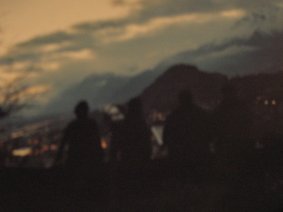
David Chiesa : contrebasse & objets
Jean Luc Guionnet : orgue et saxophone
Lionel Marchetti : dispositif électroacoustique et divers
instruments
Jérôme Noetinger : dispositif électroacoustique
En hauteur, les musiciens étaient placés à la
tribune (à côté de
l'orgue) et sur les corniches adjacentes. Au sol, une multi-diffusion
ventilait
l'ensemble du son dans tout l'espace de l'église.
Chiesa/Guionnet/Marchetti/Noetinger
Sion
w.m.o/r 21
Chiesa/Guionnet/Petit/La Casa
Belvédère
Creative Sources CS058
Site-specific, electro-acoustic free improvisations, both of these CDs are named for and reflect the settings in which they were recorded. Sharing Paris-based alto saxophonist Jean-Luc Guionnet and bassist David Chiesa in common, the sharply different sound of each notable disc results as much from the location as either quartet’s instrumentation.
Clustered adjacent to the organ of a Jesuit church in the Swiss town of Sion, Guionnet – who also doodles on the organ’s double bank of keys – and Chiesa, plus musique concrète specialists Lionel Marchetti and Jérôme Noetinger manipulating electo-acoustic apparatus, use this ecclesiastical space to reflect, amplify and transmogrify their output. Over 79 plus minutes the result is dry, cluttered and somewhat claustrophobic.
Almost as lengthy at 71 minutes, Belvédère, recorded in a scenic mountain village, references the commanding view seen in the French region of Ardèche. Twittering bird calls and intimations of footfalls through the long grass complement the captured electro-acoustic interface. More open and spacious then Sion, the one long track shouldn’t be confused with found sound, however.
Scattering a series of sensitive microphones throughout the house and the around the property, Éric La Casa – who recorded a similar project within the Paris metro with the saxophonist – captures improvisations from Guionnet’s alto, Chiesa’s bass and Emmanuel Petit’s guitar, which are seamlessly mixed together in real time.
If intermittent organ fortissimos define Sion, then unexpected vocal excursions from warbling fowl do the same for Belvédère.
Buzzing wave forms pulsating from the electric apparatus serve as a leitmotif in the Swiss session, with Guionnet’s strident tongue slaps and Chiesa’s percussive strums subordinated. Often to hack through the dense block of ambient hiss – which admittedly he contributes to with organ glissandi – the saxophonist resorts to exaggerated altissimo shrills or foghorn-like croaks. Similarly col legno string slaps that sound as if they’re given additional heft using a mallet, allows the bassist to make audible statements within a sound field dominated by dense oscillating electronic tones and triggered whooshes.
Identifiable ambience is one thing. But when spetrofluctuation, heavy-breathing slurs and concentrated tongue pops are needed by the reedist to obtrude from the miasmic motor-like reverb, it becomes apparent that some undulating electronics are excessive. The concentrated and nearly undifferentiated tonal sludge that characterize the piece’s final section suggests that the polyphony between acoustics and electronics that initially enlivened this minimalist experiment has been undermined.
Also a touch overlong, Belvédère adds a restrained feedback buzz from Petit’s guitar amp to offset the open-air, aviary accompaniment. Petit who plays acoustically in the all-guitar quartet Misère et Cordes, Chiesa who has collaborated with saxophonist Michel Doneda and Guionnet, featured in the reductionist quintet Hubbub, balance on a median between electronic and acoustic impulses here. Unlike the guitarist, however, who, except for a few identifiable strums, remains as a background sound source, this setting gives the bassist and saxophonist ample scope in which to express themselves.
Guionnet contributes protracted overblowing, plus intervallic, fortissimo reed obbligatos. These often mask the other players’ notes, but not the bird songs. Chiesa highlights spiccato scratches and sul ponticello sweeps as well as double-stopped notes. There’s even a point where the guitar and double bass strings combine in double counterpoint framing the saxophonist’s reed sputtering and squeezed vibrations.
Eventually a mellow rusticity arrives due to the contrapuntal contrast between the order musical and the untamed natural worlds. Just when you figure the resulting silence constitutes a definitive summation and finale, modern life interferes. What sounds like a large truck driving first one way then the other across the sound field twice disrupts the concluding instrumental improvisations.
Worth investigating as opposite – or is it rural verses urban – examples of how improvisers utilize found and electronically created sounds, both CDs are noteworthy, but
neither Belvédère nor Sion is completely satisfying. Maybe there’s something to be said in favor of the discipline available in a recording studio.
-- Ken Waxman
Track Listing: Sion: 1. Sion:
Personnel: Sion: Jean-Luc Guionnet alto saxophone and church organ); David Chiesa (bass and objects); Lionel Marchetti (electo-acoustic apparatus and diverse instruments) and Jérôme Noetinger (electo-acoustic apparatus)
Track Listing: Belvédère: 1. Belvédère
Personnel: Belvédère: Jean-Luc Guionnet (alto saxophone); Emmanuel Petit (guitar); David Chiesa (bass) and Éric La Casa (microphones and direct mixing)
20060828
============
VITAL WEEKLY
============
number 492
------------
week 37
------------